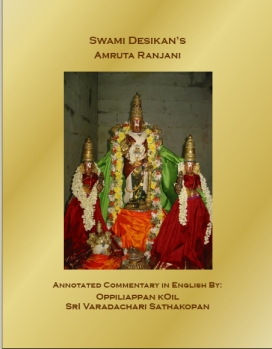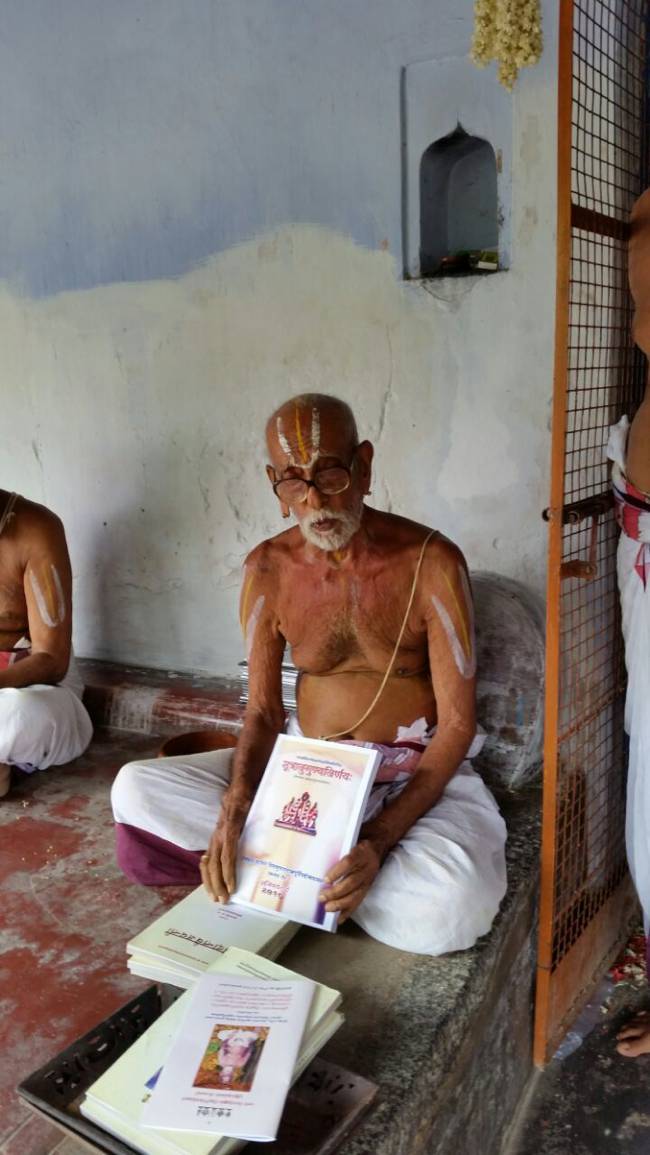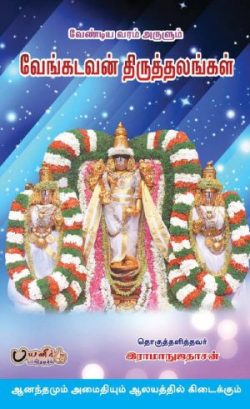Below are the details of E-books in English published by ‘Sri Nrusimha Seva Rasikan’ Sri Oppiliappan Koil Dr. V.Sadagopan on Sri Desika Prabhandham – a collection of 19 prabhandhams blessed by Swami Desikan.
Bhagavatas are requested to read these treasures and benefit.
Brief introduction to the individual prabhandhams of Sri Desika Prabhandham are given below. Most of them are in the Sundara Simham (SS) series. SS E-book numbers are given in parenthesis after the name of the Prabhandham.
1. Adaikkala Patthu (SS 31)
Swamy Desikan describes his performance of SaraNAgati at the sacred feet of Lord VaradarAjan of Kaanchi. This Prabhandham has ten paasurams. The first two Paasurams describe the two requisites for performing SaraNAgati: Inability to observe the difficult Bhakti Yogam (Akinchanyam) and disinterest to seek gods other than Sriman Narayanan ( ananyagatitvam). Next, the five angams of Prapatti, the four methods of the performance of Prapatti ( Svanishtai, Ukti Nishtai, AchArya Nishtai and BhAgavata nishtai) and the post-prapatti conductance of life. Finally, Swami Desikan performs SaraNAgati to the Lord of Kaanchi. Swamy Desikan has blessed us a Sri Sookti in Sanskrit named NyAsa DaSakam, which echos the thoughts housed in Adaikkala Patthu.
2. AdhikAra Sangraham (SS 51)
In our sampradhAyam, Srimath Rahasya Traya Saaram (RTS) has a prime place. RTS has 32 chapters (adhikArams) set in MaNipravALam mode. AdhikAra sangraham has 56 Pasurams covering the essence of the 32 individual chapters of RTS in addition to tributes to the ten AzhwArs, Madhura Kavi, Eight AchAryAs and stresses the importance of AchArya Bhakti. There are individual celebratory paasurams about the EmperumAns at Srirangam, Thirumalai and PerumAL Koil.
3. Amrutaranjanai (SS 26)
Swamy Desikan has blessed us with a Sri Sookti revered as SampradhAya Parisuddhi to banish the confusions that arose in the true interpretation of the Tattvams and RahasyArthams of our sampradhAyam . He continued on with the creation of 16 more chillarai rahasyams up to Saara dheepam. Swamy Desikan placed key paasurams at the beginning and the ending of each of these 17 chillaRai rahasyams . There are 39 such Paasurams and Swamy Desikan assembled these 39 paasurams under the title of Amruta Ranjanai since these paasurams delight the hearts of the devotees like nectar (amrutam).
4. AmrutasvAdhini (SS 50)
Another part of ChillaRai Rahasyams extend from Saara Saaram to MunivAhana BhOgam. Swamy Desikan created AmrutasvAdhini to house the essence of these chillaRai Rahasyams. This Prabhandham contains nectar like delectable content and makes us happy. The name of AmrutasvAdhini as the title arose from these thoughts. This Prabhandham covers the meanings of the three rahasyams, Charama slOkams from Srimad RaayaNam, VarAha PurANam, anjali vaibhavam and the glories of AchArya Ramanuja and concludes with the quintessence of AmalanAdhipirAn. There are 37 Paasurams in this Desika Prabhandham.
5. Arutta Panchakam ( SS 12)
One who desires Moksham should clearly understand the importance of five items : (1) The inherent nature (Svaroopam) of the Lord to be enjoyed by us (20 The inherent nature of the jeevans, who enjoy the Lord (3) the obstacles that have interfered in our enjoyment of the Lord (4) The means practiced for gaining moksham and (5) The important phalan of Bhagavad anubhavam. These 5 items are explained in 10 Paasurams in an exquisite manner.
6. AahAra Niyamam ( SS 21)
The restrictions (niyamams) that we have to observe in our consumption of food (AahAram) are covered in this Prabhandham of Swamy Desikan with 21 Paasurams. When the food is not clean and Saatvik, one’s mind does not attain tranquility. The one with an unclear and agitated mind is not fit to observe any auspicious deed prescribed by the SaastrAs. In this Prabhandham, Swamy Desikan follows the upadesams of ancient seers and instructs on what kind of food can be consumed by us and what are to be avoided to lead a life filled with devotion to Bhagavan, His BhAgavatAs and one’s AchAryan.
7. GeetArta Sangraham (SS 30)
Bhagavad Gita, the essence of Upanishads, is recognized as the life force of Mahaa Bharatam. It arose from the sacred lips of KaNNan. Recognizing its significance and greatness, Swamy AlavanthAr captured the essence of Srimad Bhagavad GitA in a sacred grantham known as GeethArtha Sangraham. AchArya RaamAnuja travelled on the path laid by Swamy AlavanthAr and blessed us with an authentic commentary known as GitA BhAshyam. Swamy Desikan created his own commentary based on AchArya RaamAnujA’s bhAshyam and discarded the wrong interpretations of the upadesams of the Lord by Para Mathams; Swamy Desikan established further that AchArya RaamAnujA’s commentary is a true interpretation of GeethAchAryan’s upadEsams. Swamy Desikan created for this purpose a Sanskrit Sri Sookti named GeetArtha Sangraha Rakshai and blessed us further with a companion Tamizh Prabhandham named GeetArtha sangraham with 21 Paasurams to cover the essence of the key slokams housed in the 18 chapters of Bhagavad Gita.
8. Charama slOka Churukku (SS 20)
The eleven paasurams of this Prabhandham covers the essence of Kannan’s charama slOkam with its ten words starting with “sarva dharmAn Parityajya “ and ending up with “ Maa Sucha:”. The upadesam to the bewildered Arjuna in the battle field was to perform unconditional surrender to the Lord and Lord alone and to seek protection from the ills of samsaaram and be free from all sorrows.
9. Thirucchinna Maalai (SS 11)
At Kanchi, Swamy Desikan heard the sacred sound of the Thirucchinnam that is played to announce the arrival of Lord VaradarAjan. In the dhvani of the Thirucchinnam, Swamy Desikan experienced and related to the deep meanings of the three rahasyams (Viz.,) AshtAksharam, Dhvayama nd Charama slOkam.
10. Thirumantira Churukku (SS 24)
Thiru Mantiram (AshtAksharam) is the loftiest of all Mantrams. It is the essence of all Vedams. It grants all desired phalans. It reveals the inner meanings of the three tattvams (viz.,) Chetanam, achetanam and Iswaran. This sacred mantram has 8 letters (aksharams). It has the power to reveal Sriman NarayaNan to those, who perform japam of this sacred mantram received through AchArya upadEsam. Swamy Desikan uses 9 Paasurams in this Prabhndham to provide the quintessence of Thirumantiram.
11. Dhvaya Churukku (SS 13)
Dhvayam is the second sacred mantram among the three that one receives as UpadEsam from a sadAchAryan. This Mantram was revealed to us by Sriman Narayana in response to the prayerful appeal from His Devi to help the jeevans to overfcome theior samsaric sufferings and gain freedom from the cycles of births and deaths. The compassionate Lord united two separate passages in the Vedams to form a mantram that can be used by all with no restrictions on the time for usage. Since two separate mantrams were united to form one mantram, this mantram is called dhvayam. The ten words that constitute this mantram has deep meanings. Swamy Desikan has sumamrized those meanings in 12 Paasurams of this Prabhandham.
12. NavamaNi Maalai (SS 23)
This Prabhandham is like a haaram (necklace) made up of nine different, beautiful gems (Nava MaNi) and hence it has been named “Nava MaNi Maalai“ by Swamy Desikan. There are nine paasurams in this Sri Sookti. The different pasurams eulogize the divine beauty of Lord Devanathan of Thiruvaheendrapuram, His dasAvatArams, the puNya teertams at His divya desam and His journey to the sea shore during the month of Maasi for a special utsavam there. At the end of this Prabhandham, Swamy Desikan reminds us that one’s samsAric bonds would be cut asunder through dhyAnam of the Lord’s unique soundharyam.
13. Paramata Bhangam (SS 58)
Swamy Desikan created a magnum opus named Para Mata Bhangam in MaNipravALam to point out the deficiencies in Para Matams and established the pristine purity of Bhagavad RaamAnuja darsanam based on Veda PramANams. In this grantam, Swamy Desikan revealed the svaroopam (inherent nature) of SaraNAgati as an upAyam (means) to Moksham and celebrated its Vaibhavam. Out of compassion for us, Swamy Desikan created a KaNDana Tamizh Prabhandham with 54 slOkams to cover the essence of the elaborate MaNipravALam Text of Para Mata Bhangam , which evaluated critically the inadequacy of sixteen different Matams to establish the supremacy of Bhagavad RaamAnuja darsanam.
14. Paramapadha sOpAnam (SS 58)
Swamy Desian has created a rahasya grantham set in MaNipravALam about the nine steps (sOpAnams) of the ladder that the jeevan has to climb to reach the Supreme abode ( Parama Padam) of Sriman NarayaNan . He has strung the Tamizh paasurams from the rahsya grantham to create this Prabhandham. The commentary on the rahasya grantham is elaborate. This Prabhandham however has only 21 Paasurams and is briefer in describing the nine steps that one interested in Moksham should climb.
15. PannirunAmam (SS 18)
This Prabhandham is about the Lord of Kaanchi, PeraruLALan. In their daily observances, VaishNavAs adorn 12 ThirumaNN Kaapu on specific sites of their upper torso and invoke 12 UpavyUha Moorthys at those places as rakshai. The hue of these 12 Moorthys, the weapons that they adorn, and the chosen sites for their presence are included in the 13 paasurams of this Prabhandham.
16. Prabhanda Saaram (SS 34)
Swamy Desikan had great abhimAnam for the 4000 sacred collect. Out of His Bhakti for the divya Prabhandam, he introduced Himself as Tamizh MaRayOn, one who follows the Tamizh Vedams of the AzhwArs. In this Prabhandam, He pays tribute to the AzhwArs as the authors of these Prabhandams, their places of Birth, their avatAra month, thirunakshatram, the names of the Prabhandams that they blessed us with, the number of Paasurams linked to them and the essence of the meanings of these Prabhandams.
17. MummaNikkOvai (SS 40)
This Prabhandam pays tribute to the divine couple at Thiruvaheendrapuram. According to Tamil Prabhandam rules, a MummaNikkOvai should have 30 verses made up of ten pasurams set in the meters of ahaval, VeNNpaa and KattaLai KalittuRai . Unfortunately only 10 of the 30 Paasurams of MummaNikkOvai created by Swamy Desikan are available to us today. Out of his great love for the Lord of Thiruvaheendrapuram, Swamy Desikan transforms himself in to a young woman with the name of Srivenkata Naayaki to express her longing for union with her Lord (Naayakan).
18. Meyvirata Maanmiyam (SS 37)
Swamy Desikan created first a rahsya grantham namesd Satya Vrata MahAtmyamin MaNipravALam. The Paasurams from that grantham has been assembled here under the title of MeyviratamAnmiyam. The incarnation of Lord Varadarajan at Hastigiri in response to the Yajn~am of Brahma devan is the topic of this Prabhandam. There are 29 exquisite paasurams in this Prabhandam.
19. SrIvaiNava Dinasari (SS 36)
SastrAs state that a VaishNavan should split the day in to five parts and perform observances specified for each of those time divisions. There are 11 Paasurams including Phala sruti that describe the observances for each of the five divisions of time : abhigamanam, upAdAnam, ijyai, svAdhyAyam and yogam. Swami links all these observances as part of the Bhagavad ArAdhanam for Lord VaradarAjan of Hastigiri.
How to get these E-Books ?
Bhagavatas can access these treasures from Swami’s portal www.sadagopan.org
By registering at the above site, bhagavatas can access Sri Desika Prabhandham E-books housed under Sundarasimham (SS) series of E-books.
Courtesy: Sri Veeravalli Raghunathan





















